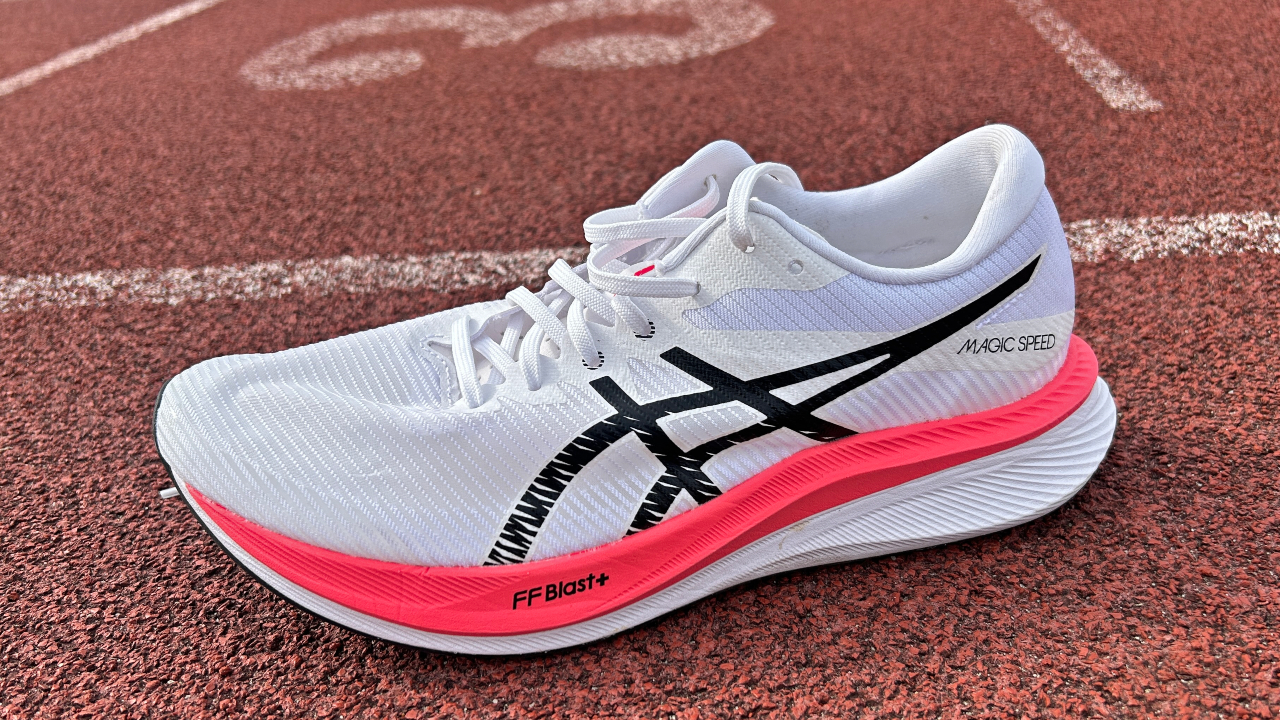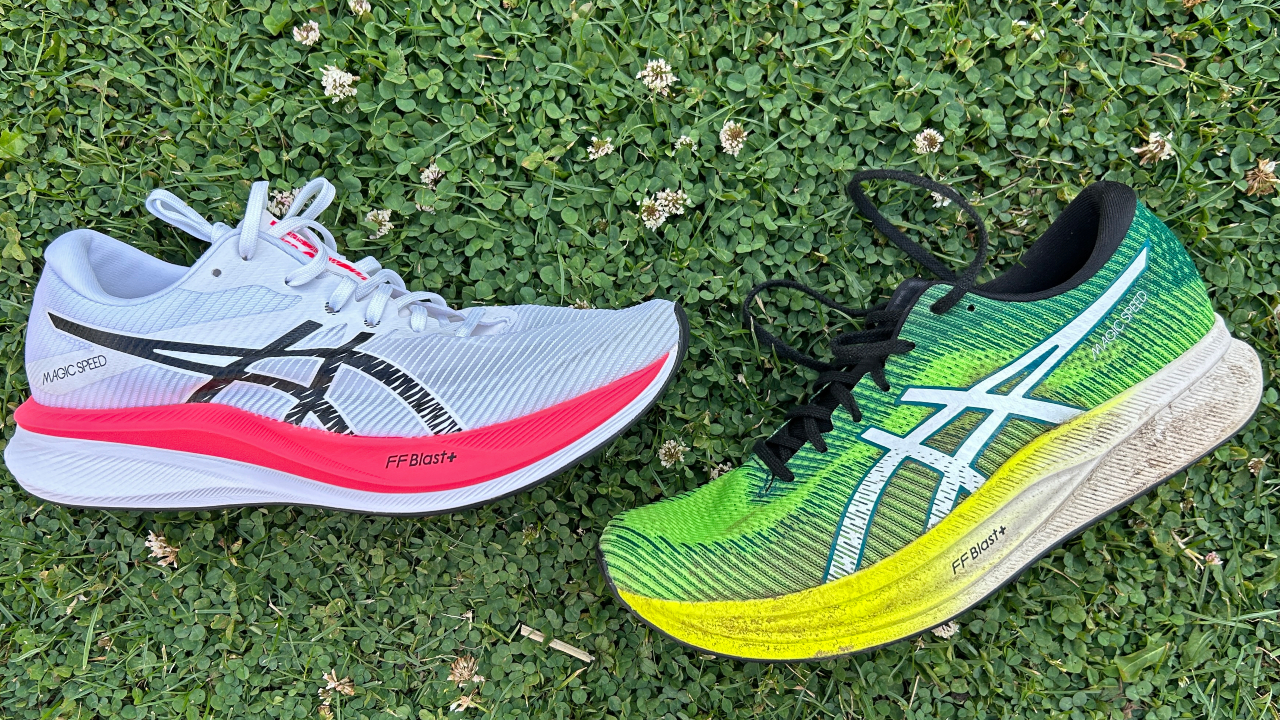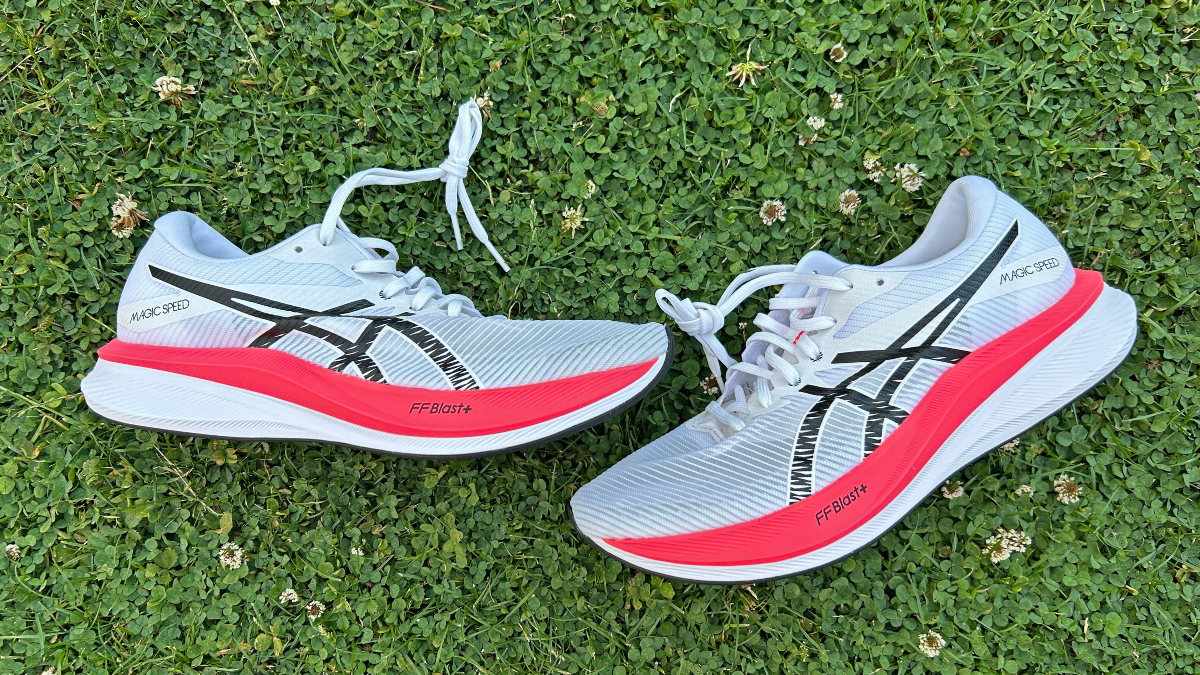Our Verdict
The Asics Magic Speed 3 is faster than its predecessor, and is now a viable alternative to expensive super-shoes, though it still doesn’t match their performance. The problem is that older-but-faster super-shoes are available for a similar price, while other plated training shoes offer more as all-rounders.
For
- Fast, efficient ride
- Lightweight
- Cheaper than super-shoes
Against
- Not as comfortable as other plated trainers
- Foam not as bouncy as others
You can trust Coach
The Asics Magic Speed 3 is about as close as you can get to a super-shoe experience without buying a super-shoe. It’s a plated super-trainer that, while it doesn’t use the best foam Asics has available, has all the other ingredients of the brand’s super-shoes—the Metaspeed Sky+ and Edge+—including a full carbon plate.
It’s a terrific shoe for speed sessions and races, and will appeal to those who don’t want to splash out on one of the best carbon plate running shoes. However, it doesn’t offer the same level of performance as a super-shoe like the Asics Metaspeed Sky+, and there are other plated trainers that offer more versatility.
Asics Magic Speed 3 Review: Price And Availability
The Asics Magic Speed 3 launched in May 2023 and costs $160 in the US and £160 in the UK. That’s cheaper than the best carbon plate running shoes, and in line with other plated super-trainers, like the Saucony Endorphin Speed 3. My Magic Speed 3 sample for this review was provided by SportsShoes.
Design And Fit

Asics has updated the Magic Speed 3 to make it a more speed-focused shoe than the Magic Speed 2. The plate in the midsole is now a full carbon plate, rather than a mix of carbon and TPU plastic, and the midsole is entirely made from FF Blast+ foam, whereas the Magic Speed 2 had FF Blast+ on top of a later Flytefoam. FF Blast+ is not the brand’s best foam—the FF Turbo material used on the Metaspeed racers—but it’s bouncier than Flytefoam.
The new shoe also has a 1mm lower stack than the Magic Speed 2, standing 36mm tall at the heel and 29mm at the forefoot for the men’s shoe, and 35mm at the heel and 28mm at the forefoot for the women’s shoe. The 7mm drop is the same as on the Magic Speed 2.
Asics has also brought its Motion Wrap upper to the line. This is the same upper as on the Metaspeed shoes, and it’s breathable and supportive while being lightweight. These changes combine to make the Magic Speed 3 lighter than its predecessor. At 7.8oz/221g in my UK size 9 (US 10) it’s dropped 0.6oz/17g and now weighs a similar amount to most carbon plate super-shoes, though the Metaspeed Sky+ is lighter at 7.3g/207g.
The other changes are that the Magic Speed 3 has a cut-out on the bottom of the midsole, which helps reduce weight, as well as a more extensive rubber cover on the outsole to increase durability, especially on the medial side and at the heel.
Sign up for workout ideas, training advice, reviews of the latest gear and more.
How I Tested This Shoe

I’ve run 22 miles in the Asics Magic Speed 3 across four runs: two speed sessions, a parkrun, and a progression run moving from easy to steady pace. This is less mileage than I usually do for a review, but I view the Magic Speed 3 as a speed shoe so I focused on fast runs in my testing rather than racking up miles with easy runs. I’ve also tested the Asics Magic Speed 2, plus the brand’s carbon racers the Metaspeed Sky+ and Metaspeed Edge+, and the top plated trainers from other brands.
Running Performance
For my first run in the Magic Speed 3, I used it for a tough workout running eight 1km reps on the road at around 3min 20sec/km pace (5min 20sec/mile). I also used the Metaspeed Sky+ for two of the reps as a comparison. It’s impressive how close to the full carbon shoe the Magic Speed 3 feels. It’s not as propulsive, and the felt less cushioned under the forefoot, but it’s a fast shoe and a good alternative to carbon racers for training sessions.
I also used the Magic Speed 3 for an all-out parkrun, running 16min 43sec over 5K. On a wet day the grip was impressive, especially when charging down a hill on the course. I did feel like the shoe was less bouncy than a true super-shoe, yet this didn’t make it any slower over this distance.
Over longer races, I’d want the extra cushion and propulsion of a shoe like the Metaspeed Sky+, and the speedy credentials of the Magic Speed 3 come at the cost of its versatility as a training shoe.

I’ve used it for slower-paced runs, but it’s not great for these thanks to its stripped-back design. It’s a shoe that wants to go fast, and I was less comfortable on easy runs in it than the Magic Speed 2. This isn’t a problem if you’re picking the Magic Speed 3 to use purely as a speed shoe, but it makes it less versatile than other plated trainers, which are comfortable on easy runs while still fast enough for interval sessions and races.
I did one track session where I used the Asics Superblast for some reps before switching to the Magic Speed 3. The Superblast is a heavier, larger shoe without a plate, but it has Asics’s FF Turbo foam in the midsole and, as a result, the ride is bouncier than with the Magic Speed 3. The Magic Speed 3 felt better than the Superblast on the track, especially for shorter reps, but the Superblast is more versatile while still being great at speed.
Is The Asics Magic Speed 3 Worth It?

The Asics Magic Speed 3 is an impressive shoe, and a good, cheaper alternative to carbon shoes if you’re looking at RRP. However, older carbon shoes like the Nike Vaporfly 2 and Saucony Endorphin Pro 3 are often in sales for a similar price, and they offer a higher level of performance for fast runs than the Magic Speed 3.
If you can nab the Magic Speed 3 in a sale then it becomes a good budget racing option once again, though it loses out to other plated trainers on versatility. The Saucony Endorphin Speed 3 and Adidas Adizero Boston 12 stand out as all-rounders that might not quite have the top speed of the Magic Speed 3, but are close to it, while being more comfortable for easy and long runs.
Overall, the Magic Speed 3 is a niche option. If you have a gap in your running-shoe rotation for a speed-focused trainer that doubles as a cheaper racing option, it will fill that gap nicely, especially if you find it in a sale. However, for most people, bagging a deal on an older carbon shoe or opting for a more versatile super-trainer is probably a smarter approach.

Nick Harris-Fry is a journalist who has been covering health and fitness since 2015. Nick is an avid runner, covering 70-110km a week, which gives him ample opportunity to test a wide range of running shoes and running gear. He is also the chief tester for fitness trackers and running watches, treadmills and exercise bikes, and workout headphones.

